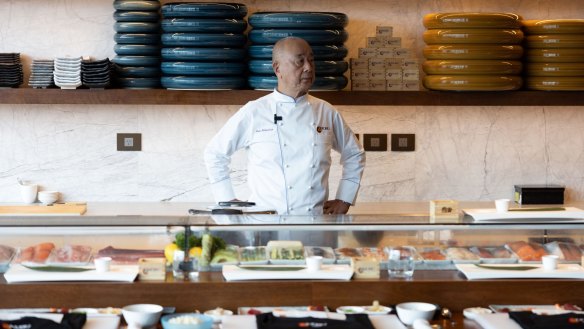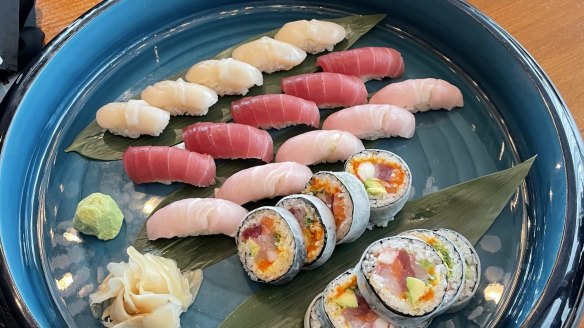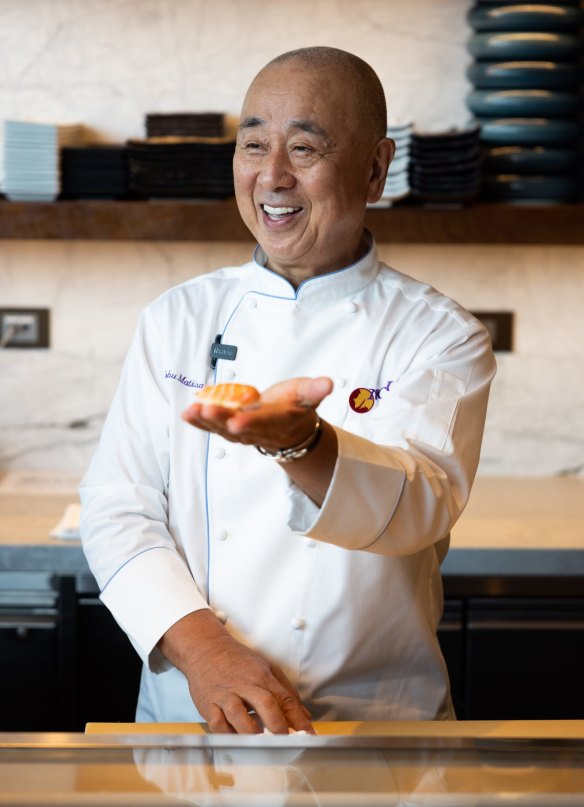The five essential tips for making sushi at home, from the master Nobu Matsuhisa

Internationally renowned chef and restaurateur Nobu Matsuhisa makes preparing sushi look simple.
During his first visit to Nobu at Crown Sydney in September, Matsuhisa deftly turns out delicate morsels of sashimi nigiri with the same finely tuned, six-step process used at each of his 59 restaurants worldwide.
The audience is mesmerised as he drapes thin slices of brightly coloured fish across his fingers, gently pressing in a small portion of sticky rice before tumbling it between his hands.

Matsuhisa is sharing his expertise in a series of sold-out public workshops in Sydney, Melbourne and Perth this month.
"Sushi looks easy, but it's important to always cook with your heart," Matsuhisa tells them.
"The only thing you need to make sushi is 10 fingers, one sharp knife and a heart."
The only thing you need to make sushi is 10 fingers, one sharp knife and a heart.
The sushi master is credited with reinventing the genre when, in 1994, he partnered with Oscar-winning actor Robert De Niro to open the first Nobu in Manhattan.
The restaurant adapted traditional Japanese sushi for the western palate, pairing paper-thin slices of raw fish with Peruvian-inspired sauces and gentle cooking techniques.
Now he's making sushi accessible to Australian cooks by sharing his tips for making simple, well-seasoned and delicately structured sushi at home.

Start with fresh, locally caught seafood
"We use local products only, no imports," Matsuhisa says. "Fresh always tastes best."
Matsuhisa suggests buying a freshly cut fillet from the market, then slicing the sashimi at home with a sharp knife.
"Not too thick, but not too thin," he says, carving a piece around half a centimetre in width.
Keep your hands damp, but not wet
A splash of cold water across your hands will ensure the sushi rice rolls smoothly beneath your fingers rather than becoming a sticky, unworkable mess.
"It can get messy!" says Matsuhisa. "Dip your hands in water, but don't put your fingers on the rice immediately after."
It's best to shake off the excess, as too much water can make the rice wet and difficult to mould.
Speed it up
Matsuhisa advises against using more than six moves to form nigiri.
"Using seven, eight or nine moves will make the rice too tight," he says.
"The best sushi has a little bit of air in it. That's why when you pop it in your mouth it's very easy to separate.
"It's very soft, you shouldn't have to bite into it."
Be careful with soy sauce
There's no need to saturate your sushi with soy sauce if the rice is seasoned adequately, says Matsuhisa.
The chef advises "just touching" the fish (or seaweed, in the case of a roll) against a shallow bowl of soy sauce before eating (if you must).
"Don't let the rice touch the sauce," he says.
Eat it ASAP
"If you make a hand roll, please eat it immediately while it's at its best and crispy," Matsuhisa says.
"When the seaweed becomes soggy it tastes different."
The same goes for nigiri, which should be picked up with your fingers and eaten in a single bite.
Matsuhisa recommends a "flip and dip" technique: flip the nigiri onto its side, then hold the nigiri between your thumb and forefingers. Dip it fish-side down in soy sauce (never rice-side down), then enjoy.
This method avoids saturating the rice in too much soy sauce, and keeps the nigiri intact as you eat it.
"Holding it for too long will make the fish warm, it's better to eat it as quickly as possible," Matsuhisa explains.
- Nobu, Crown Sydney, Barangaroo crownsydney.com.au
- Nobu, Crown Melbourne, Crown Riverwalk, Southbank crownmelbourne.com.au
The best recipes from Australia's leading chefs straight to your inbox.
Sign upMore:
